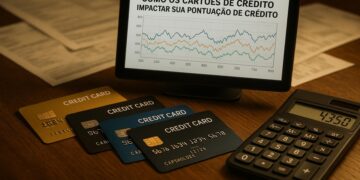How Interest Rates Affect Your Purchasing Power: A Practical Guide

The Mechanics of Interest Rates and Their Influence
The economy is a complex web of factors that intertwine to shape our financial lives. Among these, interest rates play a crucial role in determining your purchasing power. Every time you swipe your credit card or apply for a loan, these rates significantly influence how far your money will go, impacting personal finance decisions across the nation.
When interest rates rise, borrowing becomes more expensive. For instance, let’s consider a typical scenario involving a 30-year fixed mortgage. If rates increase from 3% to 5%, that could translate to a difference of hundreds of dollars in monthly payments. This surge in rates can lead to several effects, such as:
- Higher monthly payments on loans and mortgages, which can strain budgets and reduce discretionary spending. For example, a $300,000 mortgage at 5% interest incurs approximately $1,610 monthly, versus just $1,265 at 3%.
- Reduced affordability for big-ticket purchases like cars or homes. With the increase in payments, more families may find themselves priced out of the housing market, forcing them to delay purchases or seek lesser-quality options.
- Increased costs on credit card debts. For consumers carrying a balance, a rise in the interest rate could mean higher payments and a longer time to pay off debts, thereby crippling personal finances.
Conversely, when interest rates fall, your purchasing power might increase. Lower rates allow more individuals to finance their dreams without as harsh a financial burden. For example:
- Cheaper loans make it more sensible to finance a new car or home. This could mean the difference between owning your dream home and continuing to rent.
- Lower monthly payments free up cash for other expenses such as education, retirement savings, or even a vacation, ultimately benefiting the quality of life.
- Stimulated economic growth encourages more consumer spending. Lower borrowing costs can lead to increased investments and spending, boosting overall economic activity.
Understanding how these rates affect you is vital for sound financial decision-making. The nuances of interest rates not only shape personal financial choices but also influence broader economic indicators like inflation and employment rates. As borrowers, knowing how to react when rates change can empower you to strategize effectively. For instance, locking in a mortgage at a lower rate before potential increases can save thousands in the long run.
As you navigate the financial landscape, it’s important to stay informed about interest rate trends and make decisions based on your financial goals. With the right knowledge and timing, you can leverage these rates to your advantage, elevating your financial future. Now, more than ever, understanding interest rates is not just a benefit; it’s a necessity in achieving financial success.
Understanding the Impact of Interest Rates on Everyday Spending
The relationship between interest rates and purchasing power can often seem abstract, but its implications are concrete and far-reaching. To unpack this, it’s essential to recognize how interest rates function within the broader economy. They are essentially the cost of borrowing money and the return on saving it, directly impacting consumers, businesses, and investors alike.
To illustrate this effect, let’s delve into some real-world scenarios that highlight how fluctuations in interest rates can alter your financial landscape:
- Small business loans: When rates are low, small businesses are more inclined to take out loans to grow or expand operations. This could mean investing in new equipment or hiring additional staff. Conversely, higher rates may put a damper on such plans, ultimately limiting job growth and innovation.
- Student loans: The rise in interest rates can seriously affect graduates entering the workforce. A student loan at a 6% interest rate, compared to a lower rate at 4%, can affect repayment terms significantly, as higher interest translates to higher monthly payments. Such financial strain can delay major life milestones, including buying a home or starting a family.
- Investment returns: Investors closely monitor interest rate movements as they influence stock prices and bond yields. When rates rise, borrowing costs for companies increase, potentially lowering profit margins and leading to diminished stock returns. A fluctuating stock market can directly affect individuals’ retirement savings and overall wealth.
Furthermore, interest rates influence inflation, a critical term in this discussion. When rates are low, consumer spending typically increases, driving up demand for goods and services. In response, businesses may raise prices, leading to inflation. On the other hand, higher interest rates generally cool spending, helping to keep inflation in check.
For consumers, understanding these dynamics may help in making informed choices about loans, investments, and savings. With rates on the rise, for instance, locking in fixed-rate loans might be a prudent decision. Being aware of how these rates can shift your financial goals offers clarity amidst uncertainty. Moreover, it’s essential to keep tabs on economic indicators, as they give insights into potential changes in interest rates and how they may affect your finances.
As consumers become more adept at navigating these fluctuations, they can take proactive steps to protect their purchasing power. This might include exploring refinancing options or considering fixed-rate loans over variable ones during periods of increasing rates. By engaging with these financial mechanisms, you are better equipped to optimize your economic outcomes.
The interplay of interest rates and purchasing power is not just a theoretical discussion; it’s a practical matter that affects everyone—from families managing budgets to investors aiming for the best returns. A deeper understanding of these concepts fosters financial literacy, empowering individuals to make choices that align with their long-term aspirations.
Interest Rates: The Subtle Influencers of Household Budgets
As the Federal Reserve adjusts interest rates, the ripple effect within consumer households can be profound. Beyond basic loans and investments, many facets of everyday life are intertwined with interest rates, subtly steering purchasing power and spending habits.
One of the most direct impacts of interest rates is seen in credit card debt. When interest rates are low, consumers may feel incentivized to carry higher balances, acting under the impression that the cost of debt is manageable. However, as rates rise, the interest on existing balances expands, subsequently increasing monthly payments for cardholders. A credit card with a 12% interest rate can swiftly escalate to 18%, and this rise can force families to rethink discretionary expenditures such as dining out, vacations, or even simple entertainment.
Consider this: According to data from the Federal Reserve, the average U.S. consumer household carries over $6,000 in credit card debt. A shift in interest from 15% to 20% could mean an additional $300 in interest payments annually, adjusting budgets even for more stable families. Recognizing the dynamic nature of interest rates can allow consumers to manage debt more effectively and leverage periods of low rates to pay down high-interest credit cards.
Moreover, the housing market showcases a significant correlation with interest rates. For many Americans, securing a favorable mortgage rate can determine their ability to buy a home. When rates are low, the monthly mortgage payments decrease, making homeownership more accessible. A slight increase in interest rates, even a mere half percentage point, could mean thousands of dollars in added costs over a 30-year mortgage. For instance, on a $300,000 mortgage, an increase from 3% to 3.5% might result in an additional $60 a month, which accumulates to approximately $22,000 over the life of the loan. Such numbers can significantly impede potential home buyers, especially first-timers who may already be stretching their budgets.
Furthermore, families looking to finance large purchases—be it a new car or essential appliances—are similarly vulnerable to shifts in interest rates. Auto loans often have variable rates, and higher rates translate to steeper monthly payments. For example, a $25,000 car loan at a 4% interest rate versus a 6% interest rate could lead to a difference of nearly $16 per month. For families making budgetary decisions, these nuances profoundly influence whether they ultimately take the plunge on that necessary vehicle.
Another area where interest rates exert their influence is in savings accounts and retirement funds. Higher rates can yield better savings returns, encouraging more aggressive savings strategies. However, during periods of low rates, savers might feel disheartened by minimal returns, leading to decreased contributions to retirement plans, ultimately compromising long-term wealth accumulation.
Consumers can further engage with financial education resources, enabling them to make informed choices in response to fluctuating interest rates. By understanding products like variable-rate loans versus fixed-rate options, consumers can better navigate their financial futures and maintain, or even enhance, their purchasing power. Whether it involves consulting financial advisors or leveraging online tools for budgeting, becoming proactive is essential in this ever-evolving economic environment.
The intertwining factors of interest rates, consumer debt, and economic indicators underscore the need for vigilance in personal finance management. Each decision influenced by interest rates can mean the difference between financial stability and precariousness.
Understanding the Broader Implications of Interest Rates
In conclusion, the interplay between interest rates and purchasing power is a critical aspect of financial health that extends beyond mere academic discussion—it’s a living reality that affects everyday consumers. From credit card debt to mortgage decisions and large purchases, the impact of interest rates can shape household budgets in subtle yet profound ways. A seemingly minor shift in interest rates can lead to significant changes in monthly expenses, forcing families to reevaluate their discretionary spending and savings strategies.
Moreover, the decisions driven by these rates define more than just short-term financial choices; they can influence long-term wealth accumulation and financial security. As individuals grapple with varying rates, understanding options such as fixed-rate versus variable-rate loans becomes indispensable. This awareness empowers homeowners, borrowers, and savers to strategically position themselves during fluctuating economic landscapes.
To navigate this terrain effectively, consumers are encouraged to harness financial education resources, leverage budgeting tools, and perhaps seek guidance from financial professionals. As interest rates are constantly in flux, staying informed can foster better decision-making. Ultimately, being proactive rather than reactive equips consumers to manage their finances optimally and to grasp opportunities that arise from changing rates. In this complex financial ecosystem, every dollar saved in interest can translate to enhanced purchasing power, shaping a more secure future for households across the nation. The power of information is in your hands—embrace it to safeguard your financial well-being.

James Carter is a financial writer and consultant with expertise in economics, personal finance, and investment strategies. With years of experience helping individuals and businesses navigate complex financial decisions, James provides practical insights and analysis. His goal is to empower readers with the knowledge they need to achieve financial success.





